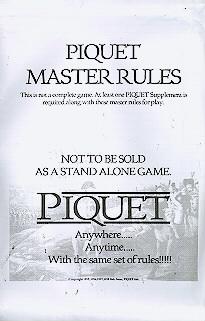

A detailed description of the system is also available.
| Period | Product |
|---|---|
| Ancients | Archon |
| Medieval | Band of Brothers |
| Marlborough Seven Years War American Revolution | Cartouche |
| Napoleonics | Les Grognards |
| American Civil War | Hallowed Ground |
| Colonial | The Din of Battle |
| WWII | Point of Attack |
| Future Products | |
|---|---|
| Fantasy | Scramasax coming late '98 |
| Thirty Years War English Civil War | Anchor of Faith |
| Mexican-American War Crimean War | Cap & Ball |
| WWI | Barrage |
| Siege (all periods) | Escalade! |
| Colorful Events Deck (all periods) | Good Old Flashy! |
| ancientgamer2003 |
|---|
| Let me begin by saying that I'm a huge fan of Piquet and its Ancients
supplement, Archon. I've been wargaming Ancients on-and-off since 1981, starting out with WRG 6th and Shock of Impact. Neither really captured the excitement of ancient battle for me, with all their little independent units behaving more like modern armored battalions than rigid formations of ancient warriors, in my honest opinion. I prefer historical refights to tournament competitions, so WRG 7th seemed like a huge step backward to me, with all sorts of gimmicky troop types, so I stopped gaming for a few years. When the new crop of Ancients rulesets came out in the early 1990's, I decided to give them a try. DBA and DBM were just too much like playing chess using a computer manual for my tastes, with all the individual color of various nationalities drained away to make it possible, e.g. for New Kingdom Egyptians to fight Norman Knights in tournament competitions. Tactica caught my excitement for a while, but the heavy restrictions on movement and single-number differential values caused battles to become rather stereotyped after a while. Armati appeared to be an attempt to make the Tactica system more like the tournament-oriented DBM, and just didn't appeal to me. I liked the attention to historical formations and troop types found in Ancient Empires, but the huge numbers of charts and tables guaranteed that a battle would wind down into a mind-numbing attritional slog-fest that seemed never to come to any real conclusion. I was just about ready to call it quits a second time, when the Piquet system and Archon appeared. One battle and I was hooked! With armies full of individual character and period flavor, semi-randomized turn sequence, and capability of handling one-time special occurences with ease, Archon has at last made it possible for me to wargame battles with all the excitement of the battles reported in ancient accounts. Commanders must prepare for unexpected turns of events and changes of fortune, which happen all the time in an Archon battle. Since it is virtually impossible for mini-maxers to precisely calculate the odds of a given battlefield action, commanders are encouraged to make the smae kind of generalized, on-the-fly judgements that their ancient counterparts did. Archon is truly different from any other ancients ruleset out there, and because of its de-emphasis on numbers-crunching in favor of the less quantifiable aspects of morale and command, it may not be every wargamer's "cup of tea." But for me, Archon is the first set of rules to accurately capture the wild swings of fortune and morale that I've read about in ancient battle accounts, and it has turned out to be exactly what I've been searching for all these years in an Ancients ruleset! |
| Nick Stern (jestern@home.com) |
| I've played three Piquet games using the Din of Battle colonial supplement, and have enjoyed them very much. In my opinion, they are very well suited for the colonial period because they supply that factor of uncertainty so lacking in most colonial rules systems. The games were GM'd by Freddie Avner, who's doing a great job of proselytizing the system here in the SF Bay Area. |
If you would like to add your opinion to this webpage, use the following form or send email to the editor.
If you know of other resources for this game, please let us know by sending email to the editor. If you have material you would like to make available to the Net, also let us know.
| Last Updates | |
|---|---|
| 9 June 2003 | updated URL for official site |
| 17 April 1999 | comments by ancientgamer2003 |
| 27 January 1999 | added Nick's comments |
| 5 January 1999 | new site for Piquet Heretics |
| 24 September 1998 | rules clarifications added |
| Comments or corrections? | |